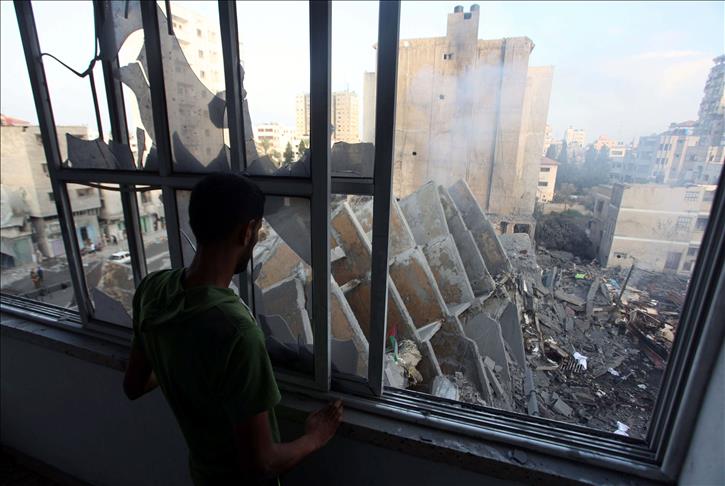
GAZA, Palestine
There is not a village in the besieged Gaza Strip that does not show signs of the aftermath of Israel’s third bout of aggression, the first anniversary of which took place on Monday.
On July 7, 2014, Israel launched a war against the Gaza Strip named Operation Protective Edge, which ended on August 26, 2014.
Hamas called the war “Eaten Straw,” referring to a Qur’anic verse regarding the defeat of Islam’s enemies.
The wreckage created by the war is estimated to be near 2.5 million tons, according to the Palestinian Ministry of Public Works and Housing.
The rubble is ever-present in front of the Palestinians’ eyes, reminding them of the harsh consequences of the Israeli aggression and its bitterness.
The Gaza Strip is known to be the world’s most densely populated area, with 1.8 million residents.
Over the course of the 51 days, the besieged enclave was exposed to Israeli military aggression, both by land and air.
The operation led to the killing of 2,147 Palestinians, among them 578 children, 489 women and 102 elderly persons.
Eleven thousand Palestinians were injured, one thousand of whom are now permanently disabled, according to a report by the Palestinian Ministry of Health.
Israel massacred 144 families, killing three or more family members from each, according to the report.
On the other side, official Israeli statements have revealed that 68 soldiers from the occupation army and four civilians, in addition to one foreign worker, died.
The number of Israelis injured was 2,522, 740 of whom were soldiers, and approximately half of whom have become disabled, according to Israeli reports released last week.
During the war, the Qassam Brigades, Hamas’ military wing, announced on July 20, 2014, that it captured Israeli soldier Shaul Aaron while repelling an Israeli army ground incursion east of Gaza City.
Two days later, the Israeli army admitted they had lost Aaron, saying he was most likely killed in a battle with Hamas fighters.
Israel accuses Hamas of detaining the corpse of another Israeli officer, Hadar Goldin, who was killed in an armed clash east of Rafah city on August 1, 2014. Hamas has neither confirmed nor denied this.
Israeli newspapers have recently published reports surrounding the possibility of the existence of “live” soldiers in the possession of Hamas, which is keeping “quiet.”
Israeli forces launched a total of 60,664 air, land and sea raids on the strip.
According to statistics compiled by the United Nations Relief and Works Agency (UNRWA), in coordination with the United Nations Development Program (UNDP), the number of housing units totally destroyed reached 12,000, with the number of partially destroyed homes reaching 160,000.
According to United Nations statements, UNRWA shelters have managed to absorb 300,000 refugees in more than 91 schools and facilities belonging to the UN organization.
There are still around 22,000 homeless Palestinians in shelters and temporary accommodation, or living with their extended families, according to statistics from the Palestinian Ministry of Public Works and Housing.
The ministry, as well as Arab and international charitable organizations, have distributed moveable homes to those affected by the latest aggression.
The ministry’s shelters committee said: “The number of temporary housing units (caravans), which are being occupied by the owners of demolished houses, has reached around 600 moving houses. Its residents are living in very harsh conditions.”
According to statistics from the Office for the Coordination of Humanitarian Affairs (OCHA), the assault led to the total demolishment of 22 schools, in addition to damaging 118 others.
During the 51-day war, the Palestinian Ministry of Economy estimated total direct and indirect losses, in houses and infrastructure, and losses in the national economy across the entire Gaza Strip, of around 5 billion dollars.
Five hundred economic facilities, large and strategic, middle and small, were damaged.
According to the Ministry of Agriculture, the war led to losses in the agricultural sector reaching $550 million.
The Ministry of Religious Endowments said that Israel totally destroyed 64 mosques during its aggression, in addition to partially damaging 150 others.
Israeli airplanes targeted more than 30 hospitals and health centers, according the Ministry of Health.
According to the Fishermen’s Syndicate, around 4,000 fishermen, who support more than 50,000 people, were exposed to heavy losses during the aggression, exceeding $6 million.
The World Bank released a statement on May 22, 2014, saying that “the unemployment level in the Gaza Strip has reached 43 percent, the highest in the world. Nearly 80 percent of the strip’s residents receive social security benefits, and 40 percent of them are still languishing below the poverty line.”
Under Egyptian auspices, Israel reached a ceasefire with Palestinian factions in the Gaza Strip on August 26, 2014.
The ceasefire ended the 51-day war and it included in its provisions the resumption of unofficial Palestinian-Israel negotiations within one month from the entry into force of the ceasefire.
The Palestinian and Israeli sides agreed on Sept. 23, 2014, to hold unofficial negotiations, with Egyptian mediation, with the aim of reinforcing the ceasefire. A new time has still not been set for the resumption of these talks.
Anadolu Agency website contains only a portion of the news stories offered to subscribers in the AA News Broadcasting System (HAS), and in summarized form. Please contact us for subscription options.







